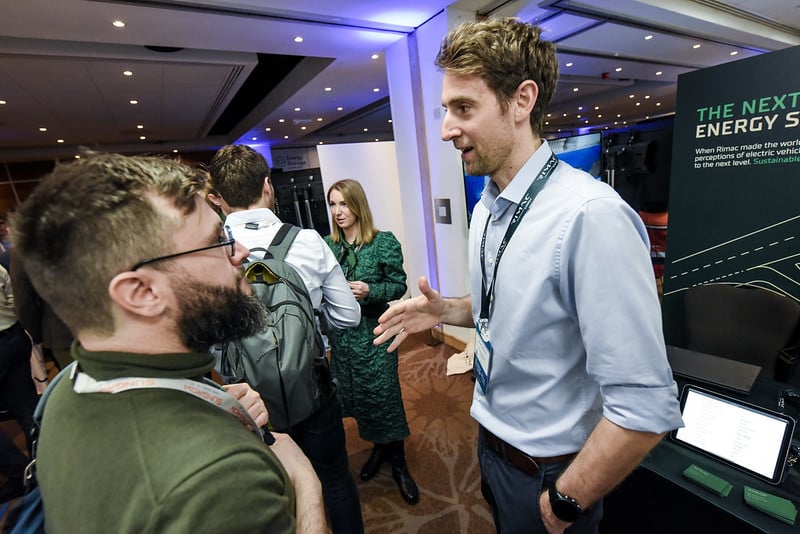
Rimac Energy is deploying its first pilot projects after announcing its entry into the energy storage system (ESS) market one year ago, and we caught up with its head of business development while at the Energy Storage Summit EU in London.
In this in-person interview at the two-day event, Rimac Energy’s Manuel Laublaettner discusses its first projects, manufacturing, cell procurement strategy and how the firm plans to stay competitive in an increasingly-competitive ESS market.
Enjoy 12 months of exclusive analysis
- Regular insight and analysis of the industry’s biggest developments
- In-depth interviews with the industry’s leading figures
- Annual digital subscription to the PV Tech Power journal
- Discounts on Solar Media’s portfolio of events, in-person and virtual
Rimac Energy is the stationary energy storage arm of Rimac Automobili, the Croatia-headquartered high-performance electric vehicle (EV) technology company which also owns a majority interest in legacy supercar brand Bugatti.
Rimac Energy announced its plans to enter the ESS market in Spring 2023 and first presented its SineStack battery energy storage system (BESS) product at our publisher Solar Media’s Energy Storage Summit Central Eastern Europe (CEE) in September 2023, officially launching it a month later.
Rimac Energy positions itself as ‘European’ player
“We are establishing ourselves as the leading European player, with a European product, European software, European manufacturing and a majority European supply chain,” Laublaettner says.
The firm’s first two projects for Croatian renewable energy developer and operator ENNA will be built at Rimac’s UK location while a larger manufacturing facility is being developed at its Croatia hub.
The first two projects will together total a ‘single-digit’ MWh figure and will go online in the second half of 2024. Laublaettner: “We’ll use these projects to prove the technology and build a track record. We’ve finished with the technological iterations to the Sinestack for the product we are launching.”
The Sinestack’s key differentiating feature it its distributed inverter topology architecture where the inverter capability is distributed amongst all of the modules giving independent control over every 18 cells in each 790kWh unit.
“We’re establishing our manufacturing lines currently, which will soon be multi-GWh and we intend to be one of Europe’s biggest manufacturers of ESS by 2030 with a significant double-digit GWh production figure.”
The company is targeting the supplying to the grid-scale, commercial and industrial (C&I) and battery-integrated EV charging market segments.
Laublaettne adds that it is hard to say who is the largest BESS manufacturer in Europe today as the capacity figures are generally quite hidden.
The projects with ENNA are in Germany and Croatia and are part of a 1GWh framework agreement between the two companies.
Staying competitive in a market with falling prices
We then ask Laublaettner what Rimac’s approach to pricing will be. Its parent company’s Nevera supercar retails for around €2 million (US$2.2 million), 30-40x the average price of a new electric vehicle (EV). Laublaettner is clear that the ESS market requires a vastly different approach.
“We don’t position ourselves as the Bugatti or the Rimac on the stationary side, we know competitive pricing is absolutely key. The performance will be the Rimac of the market, but not the pricing,” he says.
“The key thing is to have a strong supply chain and to have contracts in place that will adjust with pricing adjustments. Having the scale and ability to control the product vertically leaves us in a space where we can offer highly competitive pricing.”
Average prices in the global BESS market have fallen dramatically since the highs of 2022, with Clean Energy Associates (CEA) and system integrator NHOA Energy both saying they fell around 20% in 2023, while CEA estimates another 20% fall in 2024 (for US customers). One driver of this is the fall in lithium carbonate prices but increasing competition from Chinese companies on the global stage is also a major factor.
Battery cell procurement: China and Europe both options
A big part of the question around pricing is from where and whom Rimac procures its battery cells, which it is not building itself. The company has claimed its background in high-performance EVs means it is well-suited to extracting maximum performance from a given set of cells.
While it is presenting itself as a European company with a European supply chain, China is still the only place to go to procure lithium-ion battery cells at scale, although Europe is trying to develop its own lithium-ion battery ecosystem. Laublaettner says Rimac will offer systems with both Europe and China-made cells depending on the needs of the customer.
“At the moment, if someone wants competitive pricing the cell will come from China. We have ensured all potential suppliers of our cells will have the option for full European sourcing by 2027, and we also do see new European manufacturers but then it’s the question of the customer preferences: are they willing to pay more to have a European cell or just go for the cheaper one? That is a discussion that will continue until there is a high volume of production in Europe.”
Laublaettner also discusses how flexible the company’s SineStack solution is in terms of using different cells. Optionality is seen as key by many of the key incumbent system integrators in the market.
Laublaettner: “In general, our technology is cell-agnostic as long as the format is the same, we can use cells from different suppliers. The key thing is we look at multi-sourcing but of the same format – we’ve been working closely with leading cell suppliers and think we’ve got some really impressive cells both technically and comercially. Our solutions are all LFP right now, but we also have compatibility with Na-Ion (sodium-ion).
“The unique electrical architecture of our system, sophisticated state detection (such as state of charge estimation), and our battery optimisation software helps us extract more energy and more lifetime out of a given set of cells.”

